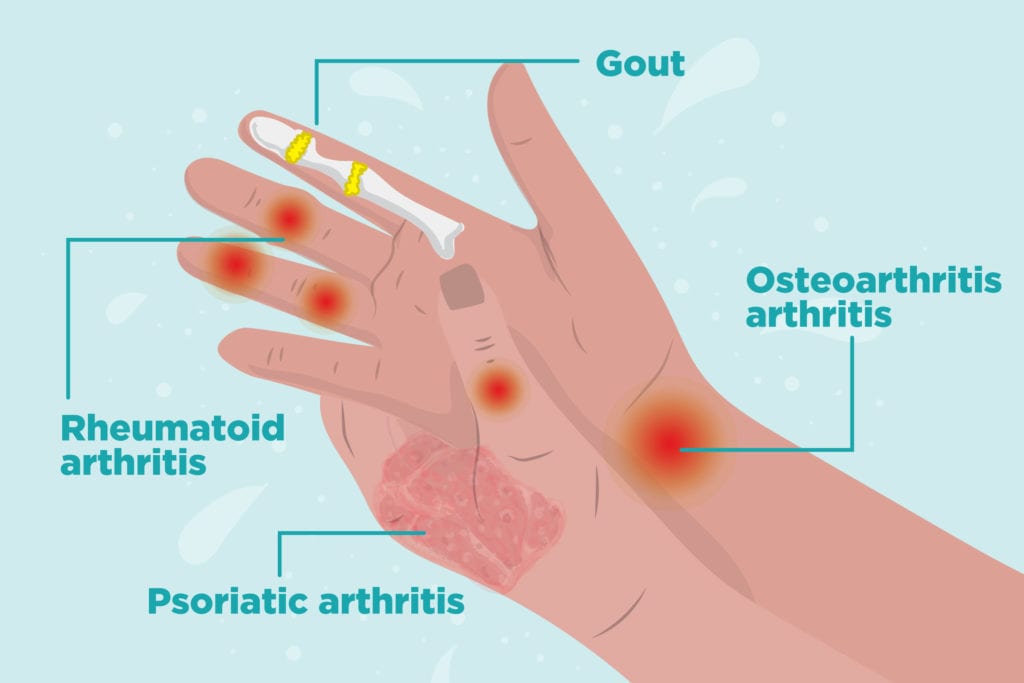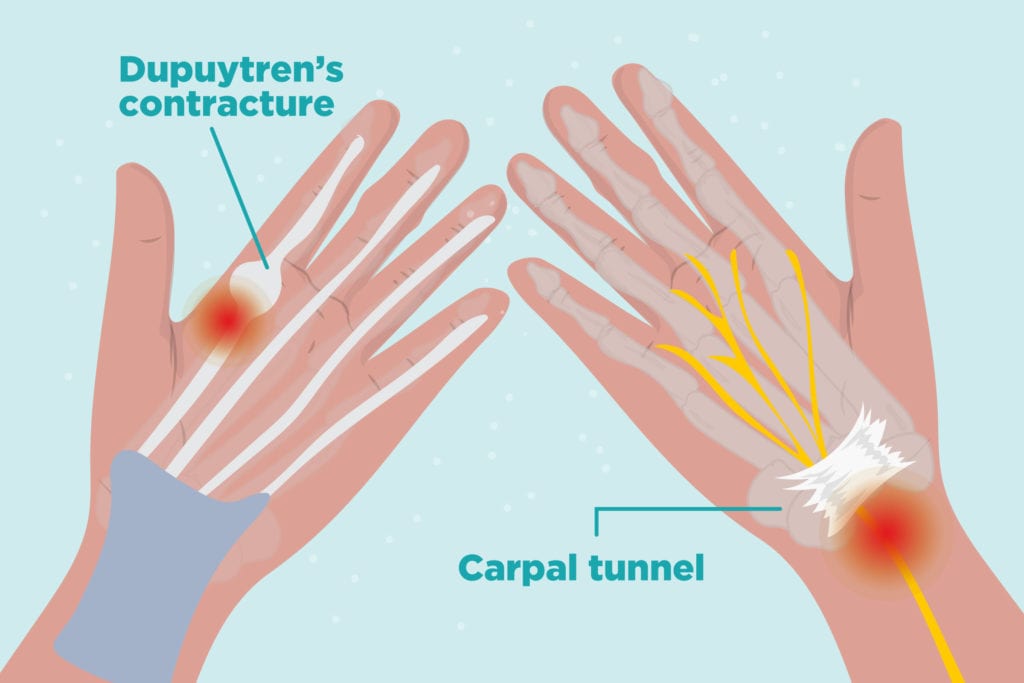

If you’ve been experiencing persistent pain in your hands, you may be wondering if arthritis could be to blame. But which type of arthritis in your hands might be the issue? The answer isn’t always obvious.
The two most common forms of arthritis — osteoarthritis (OA, or degenerative arthritis caused by wear and tear on the joints) and rheumatoid arthritis (RA, an inflammatory type of arthritis caused by inflammation in the joint) — share many symptoms in common. Plus, there are other, less common forms of inflammatory arthritis that affect the hands that your doctor will need to consider as well.
Types of Arthritis in the Hands
Both osteoarthritis and inflammatory arthritis can cause pain, stiffness (particularly in the morning), swelling, and tenderness of the joints in the hands. But people with inflammatory forms of arthritis like rheumatoid arthritis may display additional symptoms that aren’t seen in those with OA.
“OA patients lack the warmth and redness in the hands that patients with inflammatory arthritis have,” says Kevin Wayne Byram, MD, assistant professor of medicine, division of rheumatology and immunology and director of the Vanderbilt Vasculitis Clinic at Vanderbilt University Medical Center. “In addition, both hands are usually affected in those with inflammatory arthritis, while symptoms of OA are typically worse in the patient’s dominant hand.”
How long morning stiffness lasts can be revealing in determining which kind of hand arthritis you may have, he adds. People with inflammatory arthritis usually experience prolonged stiffness that lasts an hour or longer, while stiffness often eases in just five to 15 minutes in those with OA.
If your hand arthritis symptoms suggest inflammatory arthritis, Dr. Byram says the most likely culprit is rheumatoid arthritis (which often begins in the hands) but it could also be psoriatic arthritis (PsA), which commonly affects the hands too. Other symptoms of PsA include having puffy fingers and toes that resemble sausages (a condition called dactylitis), skin plaques, and pitted nails.
Your doctor will also need to consider whether your symptoms are due to palindromic rheumatism (PR), an episodic form of inflammatory arthritis (though palindromic rheumatism is rare). PR can attack any joint, but most commonly affects the hands.
Gout, a type of arthritis caused by high levels of uric acid in the body, could also be the culprit. However, while gout can affect the wrist and fingers, it is most likely to attack your big toe.
Other Possible Causes of Hand Pain


Hand pain is also a sign of Dupuytren’s contracture, a condition in which the tissue of the palm and fingers becomes thickened and tight, causing the fingers to curl inward. It’s not clear why Dupuytren’s contracture develops, though those who smoke, drink a lot of alcohol, and have seizures or diabetes are more vulnerable to developing it.
Your doctor will also consider whether your hand pain could be due to carpal tunnel syndrome, says Dr. Byram. “RA can be a cause of carpal tunnel syndrome, so if we see someone who has carpal tunnel, we’ll want to make sure they don’t have RA.” Carpal tunnel is a condition that occurs when one of the major nerves to the hand — the median nerve — is squeezed or compressed as it travels through the wrist, according to the American Academy of Orthopaedic Surgeons.
How Doctors Diagnose Arthritis Hand Pain
To determine what’s behind your hand pain, your doctor will rely on your medical history, a physical exam, and imaging and blood tests to make a diagnosis and determine what kind of arthritis hand pain (if any) you have.
“Feeling a patient’s joints during the exam can help differentiate between OA and inflammatory arthritis,” Dr. Byram says. “The swelling feels harder in those with OA because extra bone at the joints, called osteophytes, forms over time. The swelling in RA and other inflammatory disease feels softer.”
Imaging tests, such as X-rays or an MRI, can reveal joint erosion (seen in patients with inflammatory arthritis) and osteophytes and loss of cartilage (characteristic of OA).
If your doctor suspects inflammatory arthritis, they will also order blood tests to detect the presence of certain antibodies, such as rheumatoid factor or anti-CCP, that help identify RA and other types of inflammatory arthritis.
How Arthritis in the Hands Is Treated
If you’re diagnosed with an inflammatory form of arthritis, you have more treatment options than someone with OA. While nonsteroidal anti-inflammatory drugs (NSAIDs) can help manage the pain of both types of arthritis, the development of disease-modifying antirheumatic drugs (DMARDs) and biologics has vastly improved the prognosis of those with inflammatory forms of arthritis by reducing inflammation and preventing further joint damage.
Cortisone injections can be useful for those with OA and conditions such as RA, though they’re usually used in patients whose inflammatory arthritis is limited to just one or two joints, Dr. Byram says. Injections of hyaluronic acid can be helpful for those with OA (the substance helps lubricate the joints), but these are better for managing pain in larger joints like the knees rather than the hands.
At-Home Therapies for Hand Arthritis
Fortunately, there are several at-home therapies that can help ease symptoms of both osteoarthritis and RA and other kinds of inflammatory arthritis in the hands.
“I recommend using a combination of both heat and ice,” Dr. Byram says. “Heat therapy is helpful in the morning to loosen up the joint, while ice therapy is best later after a day’s worth of activity.”
He also recommends that patients with arthritis of the hands work with hand therapists. These medical professionals can show you how to make everyday activities easier and help you avoid stressing your painful joints by using assistive devices.
“A lot of these devices are designed to provide a larger area for people to grip,” Dr. Byram explains. “For example, there are grips you can slide onto eating utensils and tools that make it easier to open jars and put on your socks and shoes.”
Hand therapists can also provide you with simple exercises to maintain range of motion in your fingers, and may also recommend using splints to ease stress on your joints.
Keep Reading
If you enjoyed reading this article, you’ll love what our video has to offer.
Subscribe to CreakyJoints
Receive our newsletter and stay informed about arthritis treatments, comorbidities, and more.





